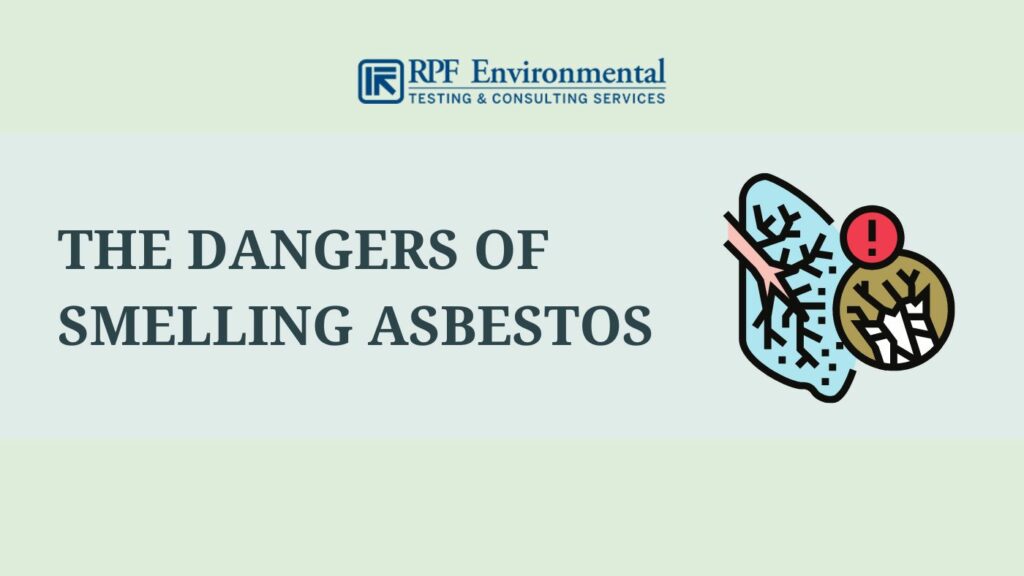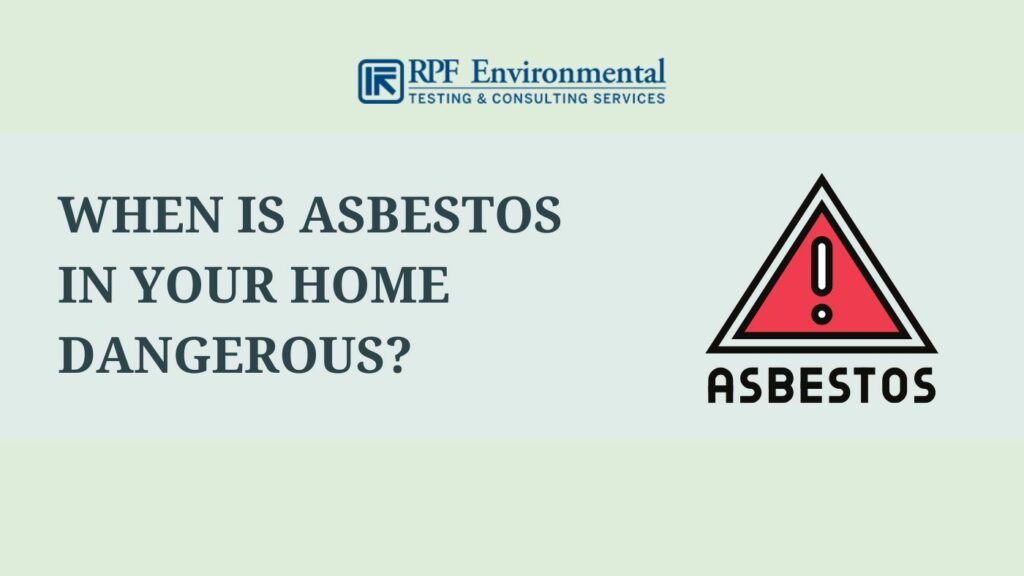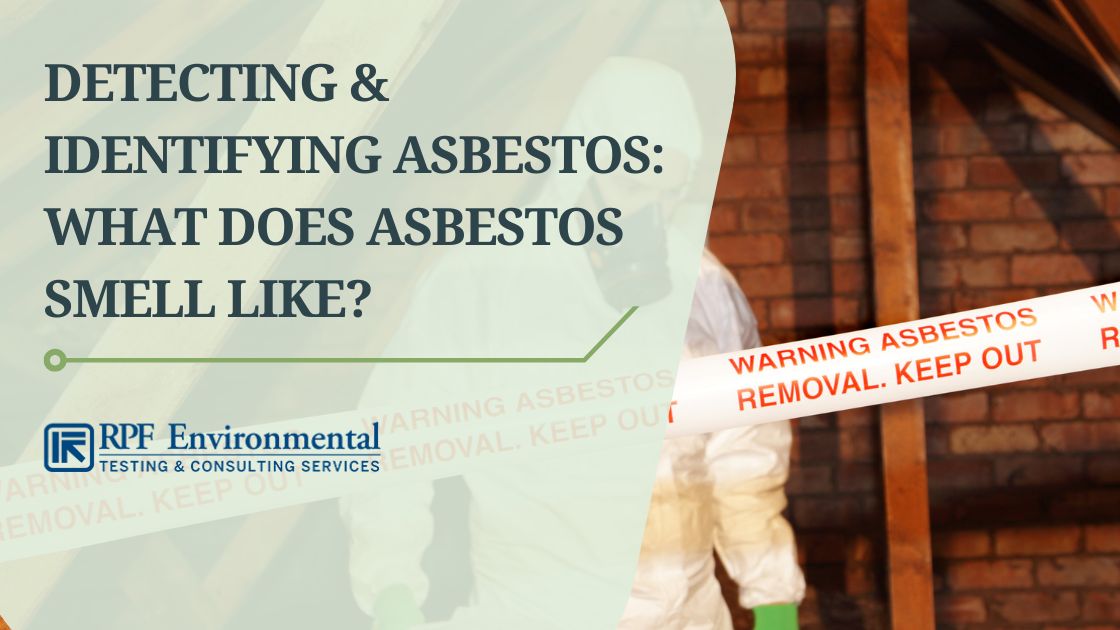Are you worried about or suspect the presence of asbestos in your home or business and are wondering if you can detect it through smell? Then you’ve come to the right place. Here, we will discuss what asbestos smells like, the dangers of smelling asbestos, and how you can effectively identify it.

RPF Environmental offers professional asbestos survey and testing in New Hampshire, Maine, Massachusetts, Rhode Island, and other areas in the New England region. Contact our licensed experts now!
Does Asbestos Smell?
Asbestos doesn’t have a smell or taste. This makes it very dangerous because you might be breathing it and still be unaware of its presence, especially when its loose fibers have become airborne.
Can You Detect Asbestos Through Smell?
Since asbestos-containing materials (ACMs) don’t release any odor, you can’t identify asbestos through smell. Though it can smell like the material containing it, it doesn’t have a distinctive smell to make identification possible. In fact, ACMs will have the same smell as those not containing asbestos. Even construction or demolition employees won’t be able to know that they are around asbestos through smell.
Can You Smell Asbestos in the Air?
This is another commonly asked question. No, you can’t smell airborne asbestos. You can’t see them either because the fibers are too small for the naked eye to see.
“It is difficult to tell when asbestos is in the air. The tiny fibers have no odor or taste, and they do not irritate your eyes or throat or make your skin itch. ” – American Lung Association
Also Read: How long does asbestos stay in the air?
The Dangers of Smelling Asbestos

Asbestos is a group of toxic minerals that can cause various diseases and is among the sole causes of deadly cancers. Though it doesn’t smell, sniffing broken ACMs will put you at risk of inhaling loose fibers that could cause cancer years after.
Who Is at Risk for Asbestos Exposure?
People working in the following occupations have the highest risk of asbestos exposure:
- Construction & demolition workers
- Building maintenance workers
- Industrial workers
- Factory workers
- Shipbuilding workers
- Power plant workers
- Firefighters
- U.S. military & veterans
Mesothelioma: A Rare Asbestos Cancer With No Cure
Mesothelioma is an aggressive type of cancer that is mostly seen in men and is caused by occupational asbestos exposure in the construction industry through inhalation or ingestion. This dangerous cancer develops in the lining of organs such as the lungs, stomach, and heart but can spread to other body parts. It can take 10-50 years before symptoms start to appear so it is often diagnosed only in its late stages when the patient only has a few months left to live.
Asbestos & Lung Cancer
According to the American Cancer Society, inhaling asbestos fibers increases the risk of lung cancer and is even greater for workers who smoke. In addition, most cases in workers develop a decade or more after exposure but cancer onset in non-smokers can take longer.
Other Asbestos-Related Diseases
Other asbestos-related diseases include the following:
- Asbestosis
- Laryngeal cancer
- Ovarian cancer
- Pleural effusion
- Pleural thickening
- Pleural plaques
Symptoms of Asbestos Exposure
Symptoms of asbestos exposure may include:
- Shortness of breath
- Persistent coughing
- Wheezing
- Hoarseness
- Coughing up blood
- Chest pain or tightness
- Difficulty swallowing
- Anemia or fatigue
- Weight loss
- Swelling of the face or neck
NOTE: Asbestos exposure doesn’t cause immediate body reactions and symptoms can take up to 50 years before they manifest.
Protecting Yourself Against Asbestos
The best and only way you can protect your family from asbestos exposure is to not come into contact with it. Furthermore, you should avoid damaging ACMs. In fact, you should leave undamaged ones alone and have qualified asbestos professionals deal with asbestos testing and removal. If you are doing major renovations, make sure to hire people trained in handling asbestos.
When Is Asbestos in Your Home Dangerous?

Toxic asbestos exposure happens when asbestos-containing products start to wear down, become damaged or are disturbed through drilling, buffing, cutting, grinding, sanding, and so on. Very small asbestos fibers and dust will be released into the air which increases the risk of breathing them in.
NOTE: Never try to remove asbestos on your own. Aside from putting your family or business at risk of exposure, you could be violating federal or state laws.
When Is Asbestos Not Dangerous?
Exposure is minimized if the asbestos-containing material is not disturbed and is in good condition because the possibility of fibers becoming airborne is unlikely.
How Can You Identify Asbestos if You Can’t Smell It?
Sample collection and laboratory testing using state-of-the-art technology by a qualified and licensed asbestos professional are the only ways you can identify asbestos. However, manufacturers of ACMs often add a distinct look and feel to their products and even include warning labels such as “asbestos-containing” or similar.
Can You Detect Asbestos Through Color?
It is possible to identify asbestos by color because naturally occurring asbestos appears blue, white, green, or brown. However, asbestos will look different once it is mixed with other materials (like construction and building materials) or painted over where identification through color becomes impossible.
A Few Things to Know About Asbestos
Below are other things you should know about asbestos:
What Are the Common Types of Asbestos?
The six types of asbestos belong to serpentine and amphibole mineral families:
Serpentine Mineral Family: Chrysotile
Amphibole Mineral Family:
- Actinolite
- Amosite
- Anthophyllite
- Crocidolite
- Tremolite
Chrysotile, also called white asbestos, is the most used variety comprising 90-95% of asbestos products used in U.S. buildings.
Where Can You Find Asbestos?
Asbestos can be found in many construction materials:
- Insulation
- Floor tiles
- Hot water pipes
- Cement sheets
- Electrical wires
- Concrete
- Paint
- Linoleum
- Floor shingles
- Textured decorated coatings
- Brick cladding
- Roofing, etc.
Also Read:
FAQs
Very small asbestos fibers can stay in the air for days after the asbestos-containing material was disturbed. But for settings with few disturbances, the fibers may take 48-72 hours to settle. However, they can become airborne again once disturbed because they are so light.
No, asbestos doesn’t have an odor so you can’t identify it through smell.
Controlling & Removing Asbestos: What to Do if You Suspect Asbestos in Your Home or Business
You cannot identify asbestos by smell, taste, or color. Only professional identification and laboratory testing of samples can determine if asbestos is present in your home/business or not. Asbestos inspection and abatement should be conducted by certified professionals only to avoid disturbing the material and causing the fibers to become airborne.
RPF Environmental is a reputable testing and consulting company that offers asbestos survey and inspection services in the New England region and beyond. We also offer site remediation/abatement management services. Contact us now!




